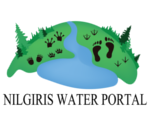Wilderness
Bangithapal Rest House at Mukurti National Park is 100 kms from Keystone Office, Kotagiri. It is situated in the western most region of the district bordering Silent Valley in Kerala. There are no human habitations in this upper area. Mainly rolling grasslands, sholas, streams, large rock faces with water glistening on them; old trees, plants (hard to botanize) from a bygone era. Due to the excessive frost and dryness, the hills were burnt brown, hardly any birds or mammals were spotted, and the place was silent – with a few of us walking through this undisturbed landscape. We trekked 25 kms – studying two wetlands in great detail. We were a team of 10 persons.
Bangithapal Wetland
There is a stream and a wetland in front of the Rest House. During this season the stream does not flow in many places. There are lotic and lentic environments. Sometimes a slow moving stream becomes fast and quick due to the terrain – stones and pebbles, high ground, sudden twists and turns. The wetland has a distinct mark – though dried, the colouration is darker than the grassland which is a layer that forms after the wetland. There are three layers which forms till the water course. First the soil or the rock strata on a hard surface; then the grassland and then the wetland (which in this case is dried) but the water flows beneath and this leads to the water course/stream. In the Bangithapal wetland there were 4 inlets into the wetland and one principal outlet and one minor outlet. The area around the wetland has a few shola trees – but distant from the wetland – they are found on the shoulders of the grassland. We measured the flow of water and the pH.
Nadugani Muttam Wetland
From Bangithapal we took 4 hours to trek to the upper most areas and the limits where the grasslands end and the rock faces begin to fall on the hot humid forests of Malabar. This looks like Tibet. Open grasslands, blue sky, high solar radiation which buns everything, tree less on this plateau – a huge wetland with 4 large deep pools of water. This was a huge wetland with several deep crags of water channels underneath the thick grass. Walking on this wetland was tough as there was no even ground. Huge grasses formed into small stools to sit on, clear water traveling all through in one direction to the outlet. There was a sheet of rock on one side then the water pool – deep, with plants inside. On one side was grassland going up the hill. The stream running underground was the principal wetland with a different colour of grass than the grassland.
Without any human habitation or population around – these wetlands are used mainly by wildlife. Fishes were found, aquatic plants; elephants come in March from a long distance for these waters, deer, Nilgiri Tahr, Sambar, wild dogs and foxes. These are wetland biodiversity sites – very well preserved and protected as one can enter these places only through special permissions from the Wildlife Warden

